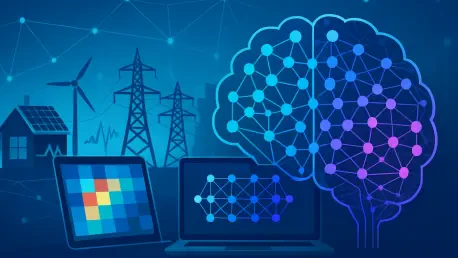The stability of the United States’ energy infrastructure stands as a cornerstone of national security, economic prosperity, and the smooth functioning of daily life, yet it faces unprecedented challenges in an era of increasing digital integration. Smart grids, the modern evolution of traditional power systems, leverage cutting-edge technologies such as real-time monitoring and distributed generation to enhance efficiency and reliability across the energy sector. However, this very connectivity that empowers smart grids also exposes them to a broader spectrum of risks, including sophisticated cyberattacks, unexpected system failures, and subtle operational anomalies. As these threats grow in complexity, traditional monitoring approaches fall short in providing the agility and precision needed to safeguard critical infrastructure. Enter machine learning (ML), a transformative technology that offers powerful tools for anomaly detection, enabling rapid identification and response to disruptions. By harnessing ML, the U.S. can significantly strengthen the resilience of its energy grids, ensuring a more secure and dependable power network for the future.
1. Exploring the Role of Smart Grids and Their Challenges
Smart grids represent a monumental shift in how energy systems operate, integrating sensors, IoT devices, and advanced communication networks to collect and analyze data in real time. This sophisticated setup allows operators to balance supply and demand with precision, seamlessly incorporate renewable energy sources, detect outages before they escalate, and optimize transmission efficiency across vast networks. The digital backbone of smart grids enables a level of responsiveness that traditional grids could never achieve, paving the way for a more sustainable and adaptable energy landscape. However, this transformation is not without its hurdles, as the interconnected nature of these systems demands robust safeguards to maintain stability. Without such measures, the benefits of smart grids risk being undermined by emerging vulnerabilities that could disrupt service on a massive scale.
Despite their advantages, smart grids introduce significant vulnerabilities that threaten their reliability and security. Cyberattacks pose a critical risk, as malicious actors can exploit networked components to interrupt services or access sensitive data, potentially causing widespread blackouts. Equipment malfunctions are another concern, where a single failure can cascade through interconnected systems, amplifying the damage. Additionally, operational irregularities—such as sudden spikes in energy usage, unexpected voltage fluctuations, or abrupt load shifts—can serve as early warning signs of deeper issues. These challenges highlight the urgent need for advanced detection and response mechanisms capable of addressing threats in real time. As smart grids become increasingly integral to the nation’s infrastructure, mitigating these risks becomes a top priority for ensuring uninterrupted power delivery and protecting public safety.
2. Advantages of Machine Learning in Grid Security
Traditional detection systems for power grids often rely on static, rule-based thresholds and predefined patterns, which can be effective for familiar issues but struggle to identify novel or subtle anomalies. These conventional methods lack the flexibility to adapt to the evolving nature of threats facing modern energy systems, leaving critical infrastructure exposed to undetected risks. As cyber threats grow more sophisticated and operational challenges become more complex, the limitations of these outdated approaches become glaringly apparent. The inability to anticipate unknown disruptions or scale with the vast data generated by smart grids underscores the need for a more dynamic and intelligent solution to protect the nation’s energy backbone.
Machine learning offers a compelling alternative, bringing a host of benefits that address the shortcomings of traditional systems. Its adaptability allows models to learn from historical data and adjust to changing conditions, ensuring relevance even as threats evolve. Early identification of anomalies is another key strength, as ML can detect subtle patterns that might escape human observation, providing critical time for intervention. Furthermore, its scalability enables the analysis of massive data volumes from multiple sources in real time, a necessity for sprawling smart grid networks. Perhaps most importantly, advanced ML algorithms reduce false positives by distinguishing genuine threats from normal operational variations, minimizing unnecessary alerts and focusing resources on real issues. This technology marks a significant leap forward in securing energy infrastructure.
3. Strategies for Anomaly Detection in Smart Grids
Anomaly detection in smart grids can be approached through various machine learning strategies, each tailored to specific challenges and data availability. Unsupervised learning, for instance, proves invaluable when labeled data is scarce, utilizing techniques like clustering (e.g., K-means) or autoencoders to establish normal operational patterns and flag deviations. This method offers the advantage of not requiring pre-labeled attack data, making it highly adaptable to previously unknown threats. A practical application lies in identifying unusual energy consumption behaviors or unexpected voltage shifts that could indicate underlying issues. By focusing on deviations from the norm without rigid predefined criteria, unsupervised learning provides a flexible first line of defense against disruptions in complex grid environments.
In contrast, supervised learning leverages historical datasets labeled as “normal” or “anomalous” to train models such as random forests or neural networks for precise event classification. This approach excels in accuracy when dealing with familiar anomaly types, offering a reliable way to recognize known cyberattack signatures or predictable equipment failures. Meanwhile, semi-supervised and hybrid methods combine the strengths of both unsupervised and supervised techniques, adapting to the dynamic nature of power grids. Experts often advocate for these combined approaches to balance flexibility with precision, ensuring comprehensive coverage. Whether detecting subtle irregularities or confirming specific threats, these varied strategies collectively enhance the ability to safeguard smart grids against a wide array of potential disruptions.
4. Implementing Machine Learning in Real-World Grid Operations
Deploying machine learning for anomaly detection in smart grids requires a structured process to transform raw data into actionable insights. The journey begins with continuous data collection from an array of sources, including sensors, smart meters, and communication networks, to build a comprehensive view of grid activity. This is followed by data preprocessing, where information is cleaned, normalized, and aggregated to eliminate noise and ensure consistency for analysis. Feature engineering then plays a crucial role, identifying key variables such as voltage levels, frequency patterns, power flow, and load variations that are most relevant for detecting anomalies. Each step is meticulously designed to lay a solid foundation for effective model development, ensuring that the resulting system can operate with precision in high-stakes environments.
Once the data is prepared, the focus shifts to model training and validation, where machine learning algorithms are built and tested to achieve high accuracy while minimizing false alarms. Real-time monitoring integrates these trained models into operational systems, enabling constant surveillance for potential anomalies. When issues are detected, response mechanisms—such as automated alerts, isolation protocols, or prompts for human intervention—ensure swift action to mitigate risks. This end-to-end process empowers grid operators to move beyond reactive measures, adopting a proactive stance that keeps critical systems stable. By embedding machine learning into daily operations, energy providers can significantly enhance their ability to anticipate and address disruptions before they escalate into major crises.
5. Policy and Collaborative Efforts for Grid Resilience
The successful integration of machine learning into grid security extends beyond technology, requiring robust policy frameworks to guide implementation and ensure consistency. Standardization emerges as a critical need, with industry-wide ML standards for data formats and detection protocols helping to create a unified approach across utilities. Equally important is information sharing, where collaboration between utilities and government agencies facilitates the exchange of threat intelligence, strengthening collective defenses. These policy measures provide the necessary structure to align technological advancements with operational realities, ensuring that innovations are applied effectively to protect national infrastructure from emerging risks.
Beyond policies, sustained investment in research and development through public-private partnerships is essential to advance machine learning capabilities tailored for grid security. Simultaneously, workforce training must be prioritized to equip engineers and operators with the skills needed to manage ML-based systems proficiently. Building this human capacity ensures that technological tools are wielded with expertise, maximizing their impact. Together, these collaborative efforts create a multi-faceted strategy that addresses both the technical and organizational dimensions of grid resilience. By fostering an environment of shared knowledge and continuous improvement, stakeholders can better prepare for the evolving challenges facing the energy sector.
6. Strengthening Infrastructure for the Long Term
Reflecting on past efforts, the journey to enhance U.S. critical infrastructure revealed a pressing need for innovative solutions, and machine learning emerged as a pivotal force in that mission. It provided a dynamic means to detect anomalies swiftly, adapt to new and unforeseen risks, and shield smart grids from a range of disruptions that once seemed insurmountable. The integration of this technology into energy systems marked a turning point, demonstrating how data-driven approaches could transform vulnerability into strength. Looking back, the commitment to blending advanced tools with strategic foresight set a powerful precedent for safeguarding national interests.
Moving forward, the emphasis must remain on cultivating not just intelligent but truly resilient grids, with machine learning continuing to play a central role in this endeavor. Stakeholders should prioritize the expansion of hybrid detection models to address diverse threats while investing in scalable platforms that can handle growing data demands. Additionally, fostering cross-sector partnerships will be vital to anticipate future challenges and develop preemptive solutions. By maintaining this momentum, the energy sector can build a fortified infrastructure capable of withstanding tomorrow’s uncertainties, ensuring reliability for generations to come.









